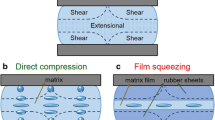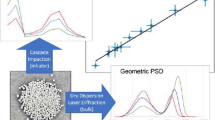Abstract
Spheroid formation mechanisms were investigated using extrusion-spheronization (ES) and rotary processing (RP). Using ES (cross-hatch), ES (teardrop), and RP (teardrop), spheroids with similar mass median diameter (MMD) and span were produced using equivalent formulation and spheronization conditions. During spheronization, the teardrop-studded rotating frictional surface, with increased peripheral tip speed and duration, produced spheroids of equivalent MMD and span to those produced by the cross-hatch rotating frictional plate surface. The roundness of these spheroids was also similar. RP required less water to produce spheroids of MMD similar to that of spheroids produced by ES. However, these RP spheroids were less spherical. Image analysis of 625 spheroids per batch indicated that the size distribution of RP spheroids had significantly greater SD, positive skewness, and kurtosis. Morphological examination of time-sampled spheroids produced by ES indicated that spheroid formation occurred predominatly by attrition and layering, while RP spheroids were formed by nucleation, agglomeration, layering, and coalescence. RP produced spheroids with higher crushing strength than that of ES-produced spheroids. The amount of moisture lost during spheronization for spheroids produced by ES had minimal influence on their eventual size. Differences in process and formulation parameters, in addition to size distribution and observed morphological changes, enabled a greater understanding of spheroid formation and methods to optimize spheroid production.
Similar content being viewed by others
References
Sellassie IG. Pellets: a general overview. In: Sellassie IG, ed.Pharmaceutical Pelletization Technology. New York, NY: Marcel Dekker; 1989:1–13.
Vervaet C, Baert L, Remon JP. Extrusion-spheronization, a literature review.Int J Pharm. 1995;116:131–146.
O'Conner RE, Schwartz JB. Extrusion and spheronization technology. In: Sellassie IG, ed.Pharmaceutical Pelletization Technology. New York, NY: Marcel Dekker; 1989;187–216.
Baert L, Remon JP. Influence of amount of granulation liquid on the drug release rate from pellets made by extrusion spheronization.Int J Pharm. 1993;95:135–146.
Fielden KE, Newton JM, Rowe RC. The influence of lactose particle size on spheronization of extrudate processed by a ram extruder.Int J Pharm. 1992;81:205–224.
Liew CV, Wan LSC, Heng PWS. Influence of polytetrafluoroethylene on spheroid production by rotary processing.STP Pharma Sci. 1998; 8:297–302.
Pisek R, Sirca J, Svanjak G, Sricic S. Comparison of rotor direct pelletization (fluid bed) and extrusion/spheronization method for pellet production.Pharm Ind. 2001;63:1202–1209.
Robinson RL, Hollenbeck RG. Manufacture of spherical acetaminophen pellets: comparison of rotary processing with multiple-step extrusion and spheronization.Pharm Technol. 1991;15:48–56.
Newton JM, Chapman SR, Rowe RC. The influence of process variables on the preparation and properties of spherical granules by process of extrusion and spheronization.Int J Pharm. 1995;120:101–109.
Heng PWS, Liew CV, Gu L. Influence of teardrop studs on the rotating frictional base plate on spheroid quality in rotary spheronization.Int J Pharm. 2002;241:173–184.
Wan LSC, Heng PWS, Liew CV. Spheronization conditions on spheroid shape and size.Int J Pharm. 1993;96:59–65.
Podezeck F, Rahman SR, Newton JM. Evaluation of a standardized procedure to assess the shape of pellets using image analysis.Int J Pharm. 1999;192:123–138.
Heng PWS, Wan LSC, Tan YTF. Optimization of spheroid production by centrifugal rotary processing.Int J Pharm. 1996;143:107–112.
Morris NJ, Warburton B. Particle size analysis of microcapsules.J Pharm Pharmacol. 1984;36:73–76.
Wanibe Y, Itoh T. Distribution of particle sizes. In: Wanibe Y, Itoh T, eds.New Quantitative Approach to Powder Technology. New York, NY: John Wiley & Sons; 1998:29–47.
Iveson SM, Litster JD, Hapgood K, Ennis BJ. Nucleation, growth and breakdown phenomena in agitated wet granulation processes: a review.Powder Technol 2001;117:3–39.
Heng PWS, Koo OMY. A study of the effects of the physical characteristics of microcrystalline cellulose on performance in extrusion spheronization.Pharm Res. 2001;18:480–487.
Hoornaert F, Wauters PAL, Meesters GMH, Pratsinis SE Scarlett B. Agglomeration behaviour of powders in a Lödige mixer granulator.Powder Technol. 1998;96:116–128.
Vertommen J, Rombaut P, Michoel A, Kinget R. Estimation of the amount of water removed by gap and atomization air streams during pelletization in a rotary processor.Pharm Dev Technol. 1998;3:63–72.
Newton JM, Chapman SR, Rowe RC. The assessment of the scale-up performance of the extrusion/spheronisation process.Int J Pharm. 1995;120:95–99.
Harris MR, Sellassie IG. Formation variables. In: Sellassie IG, ed.Pharmaceutical Pelletization Technology. New York, NY: Marcel Dekker; 1989:217–239.
Kleinebudde P, Schroder M, Schultz P, Muller BW, Waaler T, Nymo L. Importance of the fraction of microcrystalline cellulose and spheronization speed on the properties of extruded pellets made from binary mixtures.Pharm Dev Technol. 1999;4: 397–404.
Vertommen J, Rombaut P, Kinget R. Internal and external structure of pellets made in a rotary processor.Int J Pharm. 1998;161: 225–236.
Author information
Authors and Affiliations
Corresponding author
Additional information
Published: February 9, 2007
Rights and permissions
About this article
Cite this article
Liew, C.V., Chua, S.M. & Heng, P.W.S. Elucidation of spheroid formation with and without the extrusion step. AAPS PharmSciTech 8, 10 (2007). https://doi.org/10.1208/pt0801010
Received:
Accepted:
DOI: https://doi.org/10.1208/pt0801010




